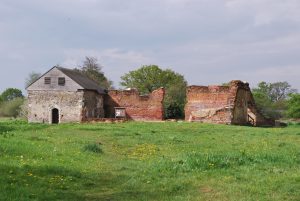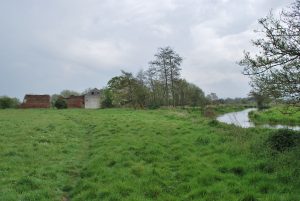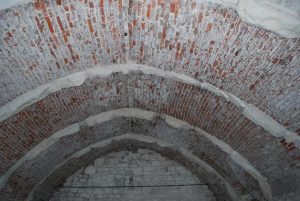




Image: cover of 2017 publication on excavations at Woking palace; ruins of Woking palace from the gatehouse area, showing branch of the River Wey, remaining vaulted stone structure interior and exterior (Photos courtesy http://www.woking-palace.org/publications.html and C.A. Stanford)
Acquired: 1509
This estate was the property of Lady Margaret Beaufort, mother of Henry VII. She ceded the manor to her son, who undertook extensive building campaigns there. Henry VIII also undertook repairs and improvements at Woking, and frequently visited there.
The site was moated with a drawbridge and connected to the River Wey, with a wharf to serve boats. A bridge stretched across the river to garden meads, with a great gate in the middle to allow barges to pass. Accounts mention suites of lodgings for the king and queen, lighted by great bay windows, a chapel, which were decorated with much glazing, painting, tiling and plastering. A kiln at nearby Clandon Common provided over 230,000 bricks for the site in 1534, used primarily for repairs (though some were taken over to Chobham for employment there). A great deal of maintenance was also required in the numerous service areas (stables, grooms houses, kitchens—for hall, for the lords, and the king’s privy kitchen) as well as orchards, an arbor, a bowling alley, a deer park with a great standing (a platform to shoot game from), to which in later years were added three new standings as Henry’s health grew less robust.
Woking continued as a royal palace until the early seventeenth century, when it was granted to a courtier who built a new mansion a mile distant. The site fell into ruin, though some portions of the buildings remain, along with the moat marking the site footprint.